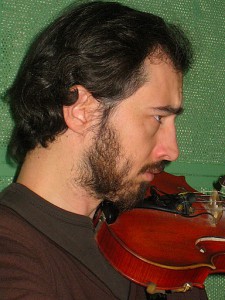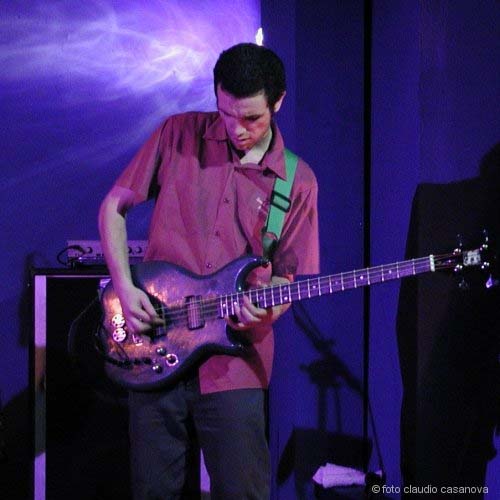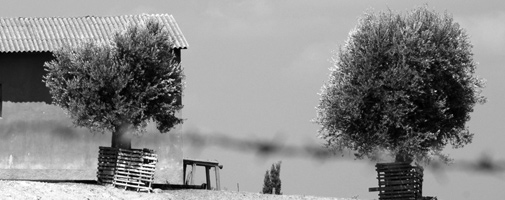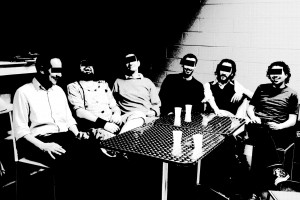“In Italia un peso fondamentale nello sviluppo del violino lo sta dando Emanuele Parrini, che ha intelligentemente distribuito i suoi contributi in progetti vari dove lo strumento è a disposizione per qualsiasi evoluzione stilistica: dalla tonalità alla free improvisation, dai progetti etnici a quelli jazzistici, Parrini non ha eguali in Italia per impegno e ricerca nel suo settore: condividendo le esperienze dell’Italian Instabile Orchestra, del Dinamitri Jazz Folklore, quelle di Tiziano Tononi e Daniele Cavallanti e partecipando a tutta una serie minuziosa di collaborazioni con altri musicisti di spicco della scena italiana e straniera, il violinista è diventato un Billy Bang in terra italiana. Tra i lavori più creativi che pescano nell’improvvisazione libera è impossibile non citare Vertical Invaders, con Tononi e William Parker, ma senza dubbio anche il recente solo album “Viaggio al centro del violino” non è da meno nè in termini di personalità che di respiro artistico.”
Ettore Garzia Poche note sul jazz italiano (11° parte): violino, viola, cello
Ha collaborato e/o collabora con : Tony Scott, Cecil Taylor, Amiri Baraka, John Tchicai, Anthony Braxton, William Parker, Joe Fonda; Butch Morris Orchestra, Marc Ribot, Cameron Brown, Keith Tippet, Ernst Reijseger, Ab Baars, Philippe Catherine, Sadiq Bey, Ensemble Tartit, Louis Bacalov, Franco Cerri, Tiziana Ghiglioni, Enrico Rava, Tiziano Tononi, Giancarlo Schiaffini, Giovanni Maier, Simone Guiducci, Gianluigi Trovesi, Antonello Salis, Maurizio Giammarco, Roberto Gatto e molti altri.
E’ violinista di Nexus, del Dinamitri Jazz Folklore e dell’ Italian Instabile Orchestra, con la quale vince il TOP
JAZZ 2007 di Musica Jazz come Formazione dell’anno;
Lavora in progetti teatrali come “Fool Lear” con Dinamitri Jazz Folklore in collaborazione con il Teatro
Politeama di Cascine; l’ “Edgar Allan Poe Project” con l’attore Antonio Catania, produzione originale del Festival Jazz di Roccella Jonica 2004, Mingus in Strings con Moni Ovadia,Visone – Storia di un Comandante Partigiano con Bebo Storti e Luigi Borgomaneri
Partecipa alla realizzazione dell’audio-libro “DIARIO DI EVA” con la voce recitante di Angela Finocchiaro e le musiche di Bebo Ferra; edito nel 2005 dalla Collana Kron e ripubblicato da Libri L’Espresso – La Repubblica
Suona nella colonna sonora del film “Assassination Tango” di Robert Duval composta da Luis Bacalov.
Prende parte al film di Carlo Mazzacurati “L’Amore Ritrovato” contribuendo con il gruppo di Riccardo Tesi alla realizzazione di parte della colonna sonora.
E’ l’ospite di una puntata della trasmissione di Stefano Bollani e David Riondino “Dottor Djembè” di Radio3.
Ha partecipato a programmi di intrattenimento culturale e musicali di Radio Rai come Fahrenheit, Radio Jazz Suite, Jazz Club di Carlo Boccadoro, Battiti di Pino Saulo, Piazza Verdi con Nexus, Dinamitri Jazz Folklore, , Italian Instabile Orchestra, Tiziano Tononi Ornettians, J. Martini Quartet, Django’s Jungle di Simone Guiducci, J. Martini Quartet, Artistic Alternative Ensemble di D.G. Espinoza, Trenoritmico di B. Scardino, Roberto Ottaviano Arcthetics.
Ha pubblicato a suo nome “Rotella Variations” dedicato all’artista visivo Mimmo Rotella , “1974 Io So damn if I know”, “Viaggio al Centro del Violino Vol.1”, “Are You Ready? – Viaggio al Centro del Violino Vol.2”, “The Blessed Prince” Education:
Education:
Studies of classical music, Siena Jazz Workshops with: G. Basso, B. Watson, T.Scott, D. Liebman, S. Lacy, F. Di Castri
He has performed and / or recorded with:
T. Scott, C. Brown, W. Parker, E. Reijseger, Sadiq Bey, P. Catherine, L. Bacalov, E. Rava,T. Ghiglioni, A. Salis,G. Trovesi, G.Schiaffini, T. Tononi, R. Gatto, M. Giammarco, E. Fazio, D. Cavallanti, P. Minafra, R. Ottaviano, U.T. Gandhi, C.Actis Dato, G. Maier,P. Botti, G. Falzone, C. Fasoli, G. Coscia, M. Rusca, G. Rosciglione,G. Munari,M. Rosa, C. Santucci, F. Bosso, G. Petrella, D. Scannapieco, J.Arnold,G.Cazzola, P. Condorelli, M. Manzi, N. Gori, S. Onorati, P. Leveratto, B. Tommaso, R. Bellatalla, F. Monico, M. Beggio, K. Gregory, T. Mangialajo Rantzer, A. Zambrini, F. Faraò, G. Capiozzo, A. Canelli, G. Renzi,G. Esposito, N. Morelli, S.Guiducci, B. Ferra, S.Senni, A. Succi,F. Beccalossi, D.Rosciglione, L. Tucci, G. Ceccarelli, A. Ariano, L. Biondini,G. Libano,M. Vaggi, A. Onorato, G. Di Leone,M. Geri,A. Di Puccio, D. G. Espinoza, M.Rabbia, D. Torto, M. Mariottini, L. Terzano, A. Tacchini,R. Bianchi, B. Caruso, T. Tracanna, R. Fassi, R. Cecchetto,Z. De Rossi, A. Melani, Dinamitri Jazz Folklore, Nexus, Les Italiens, Hot Club de Florence, J. Ouassini, A. Infantino.



